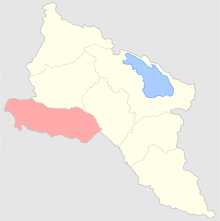Surmalinsky Uyezd
The Surmalinsky Uyezd (Russian: Сурмалинский уезд) or Surmali (Armenian: Սուրմալու Surmalu; Azerbaijani: Sürməli; Kurdish: Sûrmelî; Russian: Сурмали) was a county of the Erivan Governorate of the Caucasus Viceroyalty of the Russian Empire. It bordered the governorate's Echmiadzinsky and Erivansky Uyezds to the north, the Kars Oblast to the west, Persia to the east, and the Ottoman Empire to the south. It included most of the Iğdır Province of present-day Turkey. As part of Russian Transcaucasia, Surmali was significant as the location of Mount Ararat and the salt mines of Kulp (modern Tuzluca). Its administrative center was Igdyr.[1]
Surmalinsky Uyezd Сурмалинский уезд | |
|---|---|
.png) Coat of arms | |
 | |
| Country | Russia |
| Political status | Uyezd |
| Region | Caucasus |
| Established | 1849 |
| Abolished | 1918 |
| Area | |
| • Total | 3,688 km2 (1,424 sq mi) |
| Population (1897) | |
| • Total | 89,055 |
| • Density | 24/km2 (63/sq mi) |
Etymology
"Surmali" derives from the name of the old Armenian city of "Surmari" which evolved from "Surb Mari" (Armenian: Սուրբ Մարի "Saint Mary").[2][3] The castle of Surmari still stands today in the village of Sürmeli on the Armenian border in the Tuzluca district of Turkey's Iğdır Province.[4]
History
A part of Persia's Erivan Khanate, Surmali was annexed by the Russian Empire in the Treaty of Turkmenchay in the aftermath of the Russo-Persian War of 1826–28. The district was first administered as part of the Armenian Oblast and then the Erivan Governorate.[5] In 1829, Baltic German explorer Friedrich Parrot of the University of Dorpat (Tartu) traveled to Surmali as part of his expedition to climb Mount Ararat. Accompanied by Armenian writer Khachatur Abovian and four others, Parrot made the first ascent of Ararat in recorded history from the Armenian monastery of St. Hakob in Akhuri (modern Yenidoğan).[6] After the Russian Revolution, Surmali was briefly governed by the First Republic of Armenia.[7] However, the district was later ceded to Turkey by the Soviet Union in the treaties of Moscow and Kars.[8]
Demographics
According to the Russian family lists accounts from 1886, of the total 71,066 inhabitants of the district, 34,351 were Tatars (modern Azerbaijanis; 48.3%), 22,096 Armenians (31.1%), and 14,619 Kurds (20.6%).[9]
According to the 1897 Russian Empire Census, the population of the district was 89,055, of which 41,417 were Tatars (46.55%), 27,075 Armenians (30.4%), 19,099 Kurds (21.45%), and 1,361 East Slavs (Russians, Ukrainians, and Belarusians; 1.52%).[10] The largest city in the district was Igdyr, which had a total population of 4,680, of which 3,934 (84.05%) were Armenians and 559 (11.94%) East Slavs.[11][12]
References
- Tsutsiev, Arthur (2014). Atlas of the Ethno-Political History of the Caucasus. Translated by Nora Seligman Favorov. New Haven: Yale University Press. p. 59. ISBN 9780300153088.
- De Clavijo, Ruy González (2004). Embassy to Tamerlane, 1403-1406. London: RoutledgeCurzon. p. 186. ISBN 9780415344890.
Surmari, Sulmari, or Sulmari, the Armenian Surb Mari, that is Saint Mary...
- (in Armenian) Danielyan, E. L. (2010). "Հայոց պատմական և քաղաքակրթական արժեհամակարգի պաշտպանության անհրաժեշտությունը [On the Necessity of Protecting Armenian Historical and Civilizational System of Values]". Lraber Hasarakakan Gitutyunneri (in Armenian) (3): 68. ISSN 0320-8117.
...Սուրմալուի (Սուրբ Մարի) գավառը...
- Parrot, Friedrich (2016) [1846]. Journey to Ararat. Translated by William Desborough Cooley. Introduction by Pietro A. Shakarian. London: Gomidas Institute. p. ix. ISBN 9781909382244.
- Tsutsiev, pp. 16, 19, and 21.
- Parrot, p. 139.
- Tsutsiev, p. 75.
- Tsutsiev, p. 81.
- (in Russian) Свод статистических данных о населении Закавказского края, извлечённых из посемейных списков 1886 года, г. Тифлис, 1893
- (in Russian) 1897 Census, Surmalinsky Uyezd Demoscope Weekly
- (in Russian) 1897 Census, Igdyr City Demoscope Weekly
- (in Russian) Первая Всеобщая перепись населения Российской империи 1897 г. Том 24, Эриванская губерния, г. Санкт-Петербург, 1905